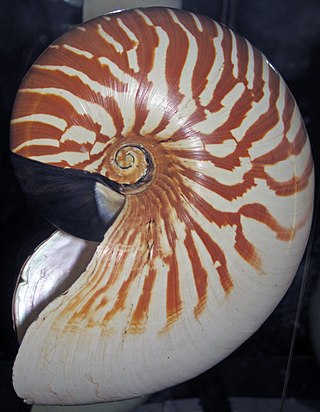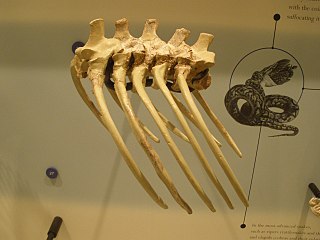
The nautilus is a pelagic marine mollusc of the cephalopod family Nautilidae. The nautilus is the sole extant family of the superfamily Nautilaceae and of its smaller but near equal suborder, Nautilina.

The chambered nautilus, also called the pearly nautilus, is the best-known species of nautilus. The shell, when cut away, reveals a lining of lustrous nacre and displays a nearly perfect equiangular spiral, although it is not a golden spiral. The shell exhibits countershading, being light on the bottom and dark on top. This is to help avoid predators, because when seen from above, it blends in with the darkness of the sea, and when seen from below, it blends in with the light coming from above.

Presbyornis is an extinct genus of anseriform bird. It contains two unequivocally accepted species; the well-known P. pervetus and the much lesser-known P. isoni. P. pervetus was approximately the size and shape of a goose, but with longer legs; P. isoni, known from a few bones, was much larger, more than swan-sized. Other fossils, more doubtfully assigned to this genus, are also known.

Nautilus is a genus of cephalopods in the family Nautilidae. Species in this genus differ significantly in terms of morphology from those placed in the sister taxon Allonautilus. The oldest fossils of the genus are known from the Late Eocene Hoko River Formation, in Washington State and from Late-Eocene to Early Oligocene sediments in Kazakhstan. The oldest fossils of the modern species Nautilus pompilius are from Early Pleistocene sediments off the coast of Luzon in the Philippines.

Nautilus stenomphalus, also known as the white-patch nautilus, is a species of nautilus native to the Great Barrier Reef. N. stenomphalus is very similar to N. pompilius and may in fact represent a subspecies. It is separated by the absence of a thickened callus and the presence of white patches in the umbilical and shoulder regions of the shell. The sheaths of this species have scalloped edges compared with the smooth sheaths of N. pompilius. N. stenomphalus also differs slightly in hood ornamentation. The shell is usually up to around 180 mm in diameter, although the largest specimen ever recorded measured 201 mm.

Nautilus cookanum is an extinct species of nautilus. It lived during the Eocene epoch. N. cookanum placed within the genus Nautilus, together with extant species based on their shared shell characters. Fossils of the species from the Late Eocene Hoko River Formation are noted as one of the two oldest occurrences for the genus.
Banksieaephyllum is a plant genus that encompasses organically preserved fossil leaves that can be attributed to the Proteaceae tribe Banksieae, but cannot be attributed to a genus.

Madtsoiidae is an extinct family of mostly Gondwanan snakes with a fossil record extending from early Cenomanian to late Pleistocene strata located in South America, Africa, India, Australia and Southern Europe. Madtsoiidae include very primitive snakes, which like extant boas and pythons would likely dispatch their prey by constriction. Genera include Madtsoia, one of the longest snakes known, at an estimated 10 metres (33 ft), and the Australian Wonambi and Yurlunggur. As a grouping of basal forms the composition and even the validity of Madtsoiidae is in a state of flux as new pertinent finds are described, with more recent evidence suggesting that it is paraphyletic as previously defined.
Obinautilus is an extinct genus of shelled cephalopod that has been variously identified as an argonautid octopod or a nautilid. It is known from the Late Oligocene to Pliocene of Japan. The shell is discoidal and very involute, with rapidly expanding and compressed whorls, fine radial ribs, a rounded venter with a shallow furrow, and almost closed umbilicus.

Florissantia is an extinct genus of flowering plants in the Malvaceae subfamily Sterculioideae known from western North America and far eastern Asia. Flower, fruit, and pollen compression fossils have been found in formations ranging between the Early Eocene through to the Early Oligocene periods. The type species is Florissantia speirii and three additional species are known, Florissantia ashwillii, Florissantia quilchenensis, and Florissantia sikhote-alinensis.

Odontopteryx is a genus of the extinct pseudotooth birds or pelagornithids. These were probably rather close relatives of either pelicans and storks, or of waterfowl, and are here placed in the order Odontopterygiformes to account for this uncertainty.
Pseudodontornis is a rather disputed genus of the prehistoric pseudotooth birds. The pseudotooth birds or pelagornithids were probably rather close relatives of either pelicans and storks, or of waterfowl, and are here placed in the order Odontopterygiformes to account for this uncertainty. Up to five species are commonly recognized in this genus.

Archiinocellia is an extinct genus of snakefly in the family Raphidiidae known from Eocene fossils found in western North America. The genus contains two species, the older Archiinocellia oligoneura and the younger Archiinocellia protomaculata. The type species is of Ypresian age and from the Horsefly Beds of British Columbia, while the younger species from the Lutetian Green River Formation in Colorado. Archiinocellia protomaculata was first described as Agulla protomaculata, and later moved to Archiinocellia.

Azolla primaeva is an extinct species of "water fern" in the family Salviniaceae known from Eocene fossils from the Ypresian stage, found in southern British Columbia.

The Hoko River Formation is a Late Eocene marine sedimentary geologic formation. The formation is exposed in outcrops along the Strait of Juan de Fuca on the Olympic Peninsula in Washington state, USA. It is known for containing numerous fossils of crabs. It overlies the older Lyre Formation and underlies the younger Makah Formation.

Meretrix is a genus of edible saltwater clams, marine bivalve molluscs in the family Veneridae, the Venus clams. They appeared in the fossil record in the Cenomanian age.
Etayoa is an ungulate of the family Carodniidae in the order Xenungulata that lived during the Early Eocene in northern South America.

Aphaenogaster dlusskyana is an extinct species of ant in the subfamily Myrmicinae known from a single Middle Eocene fossil found in amber on Sakhalin. At the time of description A. dlusskyana was one of eight ant species known from Sakhalin fossil.

The Itaboraí Formation is a highly fossiliferous geologic formation and Lagerstätte of the Itaboraí Basin in Rio de Janeiro, southeastern Brazil. The formation reaching a thickness of 100 metres (330 ft) is the defining unit for the Itaboraian South American land mammal age (SALMA), dating to the Early Eocene, approximately 53 to 50 Ma.

Dipteronia brownii is an extinct species in the soapberry family (Sapindaceae) described in 2001. Fossils of D. brownii are known from stratigraphic formations in North America and Asia ranging in age between Paleocene to Early Oligocene.















